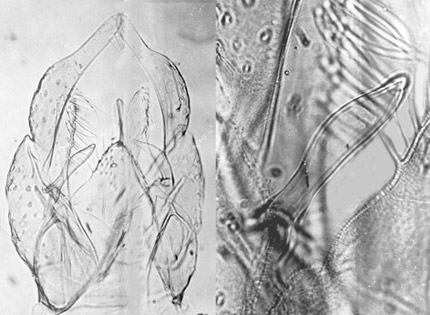Species 2t. C. calligraphus-group - sp. incert.The identity of this species is quite uncertain. No larva is known that fits the few criteria listed by Wülker. It is possible that it is an early designation for the sample from Winter Haven, Florida, since the description and the few images available show a mixture of characters of C. calligraphus and C. species WOC, both of which were found together at this location (see Spies et al. (2002). Adult  Male terminalia of C. species 2t (left), and superior volsella (right). Possibly no setae near middle of tergite IX. Superior appendage most like Strenzke's S(f)-type. Anal point narrow.This could be a male of C. calligraphus. Larva: gross morphology not known. Mentum (below) with pointed teeth; c1 tooth relatively broad with parallel sides, c2 teeth well developed and separated (type III), as that of C. sp. WOC.  Mentum and ventromentum of C. species 2t. Cytology: 4 polytene chromosomes with pseudothummi arm combination AE, BF, CD, G.  Distal end of arm F (above), and arm G (below) of C. species 2t. Found: Florida – Winter Haven and Cannon Lake, Polk Co. Wülker noted the existence of polymorphism in arm G, but did not indicate the nature or extent of this polymorphism in the Winter Haven material. It may reflect the difference between the G of C. calligraphus and C. sp. WOC. |
Modified: 12 September 2018
Access: Unrestricted
Copyright © 2000-2018, Jon Martin.